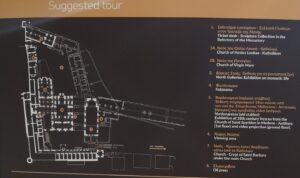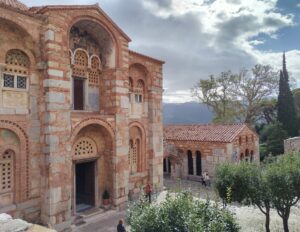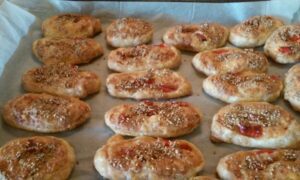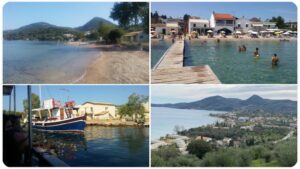Hosios Loukas, a spectacular Byzantine monastery
It was a sunny autumn day when I discovered, much to my delight, this secret gem of Greece… Now, because of my strong faith, I have visited many monasteries in my life, but I had never heard of Hosios Loukas.
I consider it very fortuitous, therefore, that my coach journey to Arachova late last year included a stop at this monastery.
Built on the western slope of Mt Elikon with a valley teemed with olive trees stretching out before it, this 10th century A.D. Byzantine monastery is more than that. It is, rather, a fortified complex of not one but three churches, each one built at a different time in a different style.
The combination of all three provide visitors with an awe-inspiring, highly diverse visual experience.
‘Katholikon’ was a marvel to my eyes
The main church, ‘Katholikon’, is dedicated to Hosios Loukas. ‘Hosios’ (or the more phonetically accurate, ‘Ossios’) means ‘Devoted to God’ and it is a title that the Greek Orthodox Church has given over time to many devoted monks and nuns.
Hosios Loukas was a hermit called Loukas Stereiotis, and he lived in the area since 945 A.D. until his death in 953 A.D. He founded the monastery and was alive when the church of the Virgin Mary was built in the middle of the 10th century. The larger church of Katholikon was built later beside it, early 11th century.
His full-body relics are kept on display today inside the Katholikon. They were stolen by the Crusaders during the 13th century A.D. and kept in the Vatican for centuries before their repatriation.
When I entered the imposing Katholikon, my jaw literally dropped and I was overcome with awe. The exterior was imposing enough but nothing prepared me for the scale of things on the inside… for the stunning marble slabs, the intricate designs on everything I caressed with my eyes, especially the beautiful mosaics and the frescoes that are characteristic of the 10th-11th century A.D. because of the golden background.
Even the sunlight contributed that morning to make the scene one of astounding beauty, as it streamed in eagerly through the many elaborate windows.
On the left of the interior there is a portico, where people can pay their respects to the full-body relics of Hosios Loukas and then walk on a little further to enter the other, adjacent church…
More awe-inspiring beauty awaited me at the adjacent Virgin Mary church (Theotokos)
The masonry and brickwork of this older church was breathtaking. From what I found out later on line, it boasts a special style of masonry that combines stones with bricks to form decorative motifs. In time, it became the prototype for all the classical Byzantine churches of southern Greece.
I have very basic knowledge of Byzantine architecture, but I can tell you it was just as spectacular as Katholikon. It was amazing for me, actually, to see that mere stones and bricks can create such a stunning decoration. Truly, this church has all it takes to stand unabashed beside another that practically beams ‘dressed’ in polished marble.
There were many people inside Virgin Mary church, so I just followed the queues to explore it…
In one corner, people gathered up to write names on little notes of papers, leaving coins to the priests in return for blessings for their ailing loved ones or their departed from this world.
Another monk stood further away offering blessed chunks of bread to the visitors.
Outside, in the streaming sunshine, eating my piece of blessed bread, I closed my eyes for a while and inhaled the crisp Autumn air, feeling really blessed to be there as the birdsong reached my ears.
The main court was a pleasure to explore, and I went stepping up and down on different levels to photograph the two churches and the buildings of the monks’ cells from different angles against a cheerful azure sky…
Hosios Loukas had chosen to build the Katholikon on top of an existing church, that is still open to the public today. It is a stunning large crypt with groin vaults forming the roof, and it is dedicated to Agia Varvara (St Barbara).
Its entrance is around the back of the Katholikon building–not accessible from within the church. The tomb of Hosios Loukas is situated inside it.
Outside the monastery, nature beckons enticingly…
There is a large green space there, with grass and trees, and a couple shops that offer a wide variety of religious merchandise and local produce. And they also serve coffee, which visitors can enjoy sitting in this beautiful space that overlooks the monastery and the mountains on one side and the vast valley on the other.
The birdsong reached my ears busy and sweet as I took in the breathtaking views, and it was the perfect way to seal my memories of this awe-inspiring, blessed place, before it was time to go–much too early for my liking, but it couldn’t be helped as we were on a coach.
But, perhaps next time I’ll have more time to explore more spaces of this fortified Byzantine ‘little town’. According to the plan on display, there are old stables, an oil press, a museum, and other places of interest for the visitors.
My eagerness to see them serves as a wonderful motive for me to return.
Travel information: Hosios Loukas is in Boeotia (Viotia) north of Attica, about 170 kms from Athens along the motorway route Athens-Levadia-Delphi. It can be easily combined with other places of interest for a day out from Athens. It is situated in the area of Distomo, a part of Greece forever reminiscent of the harrowing atrocities against its locals carried out by the Nazis in WWII. Distomo is a beautiful village with places of archaeological interest and a Holocaust Museum. The bustling and quite cosmopolitan town of Arachova is 30 kms away from the monastery. You can see my travel report from Arachova here. Arachova is a highly recommended Greek destination. Some say it’s overrared, but others adore it and return there every winter for a quick break, so I guess you’ll have to decide for yourself! 😉
VISIT FACEBOOK TO SEE MORE PHOTOGRAPHS FROM HOSIOS LOUKAS!
Easy and quick to make!
These puff pastry pinwheels are perfect to serve with meze and ouzo (or beer!), or you can use them as a side dish with virtually any meal. Just buy a ready pack of puff pastry and make them in no time!
The filling is cheese, bacon and red pepper. They make a treat that’s both colourful and highly delicious. So comforting during winter to have straight out of the oven. And the crunchiness is all the money…
Go on, impress your family and friends!
GET THE RECIPE!
OOPPAAA! SIGN UP TO MY BIMONTHLY NEWSLETTER AND GET 3 BOOKS FROM ME AS A WELCOME GIFT! SEE BELOW FOR THIS OFFER!
YOU KNOW WHAT THEY SAY… SHARING IS CARING! Tweet this to spread some love:
Interested in travel, food and books from Greece? Here's a blog you will love! #blogger #writer #Greece Share on X
3 FREE books for you! Sign up below to receive them instantly!
NEW! Clean Christmas romance. Single mother Cathy Roussos gave up on love long ago, and veterinarian Alex Rallis doesn’t believe in it, but one magical Christmas on a Santorini farm might just change everything…
Check it out on Amazon Read a FREE sample!
A clean romantic suspense short read with an unreliable narrator that’ll keep you guessing! Vera is losing her mind over famous actor Yannnis Ksenos, except, she isn’t just a fan… Now, she plucks up the courage to ring his doorbell… Visit Amazon














